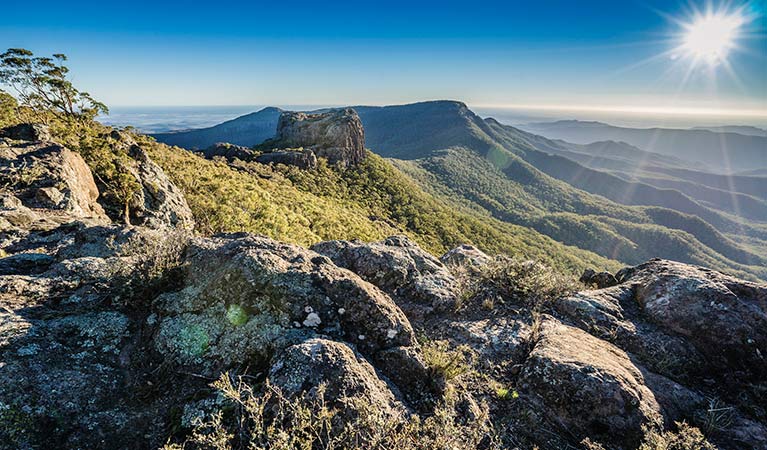Mount Kaputar National Park
Overview
With camping, cycling, walking, horse riding and bird watching waiting for you on this scenic mountain range, Mount Kaputar is a fantastic wilderness escape in NSW.
Read more about Mount Kaputar National Park
Be awed by towering forests, breathtaking rock formations and stunning scenery at Mount Kaputar National Park. Roughly 1 hour's drive from Narrabri in northern NSW, Mount Kaputar is an explorer’s paradise.
Take in the views from the park’s lookouts, have a relaxing picnic or barbecue, or stay overnight in a picturesque campground or cabin accommodation. Bring your binoculars to enjoy bird watching, or to search for possums and greater gliders after dark. Or for a more adventurous trip; walk one of the park's many tracks, or go for a mountain bike or horse ride through the spectacular landscape.
Local alerts
For the latest updates on fires, closures and other alerts in this area, see https://www.nationalparks.nsw.gov.au/visit-a-park/parks/mount-kaputar-national-park/local-alerts
Map
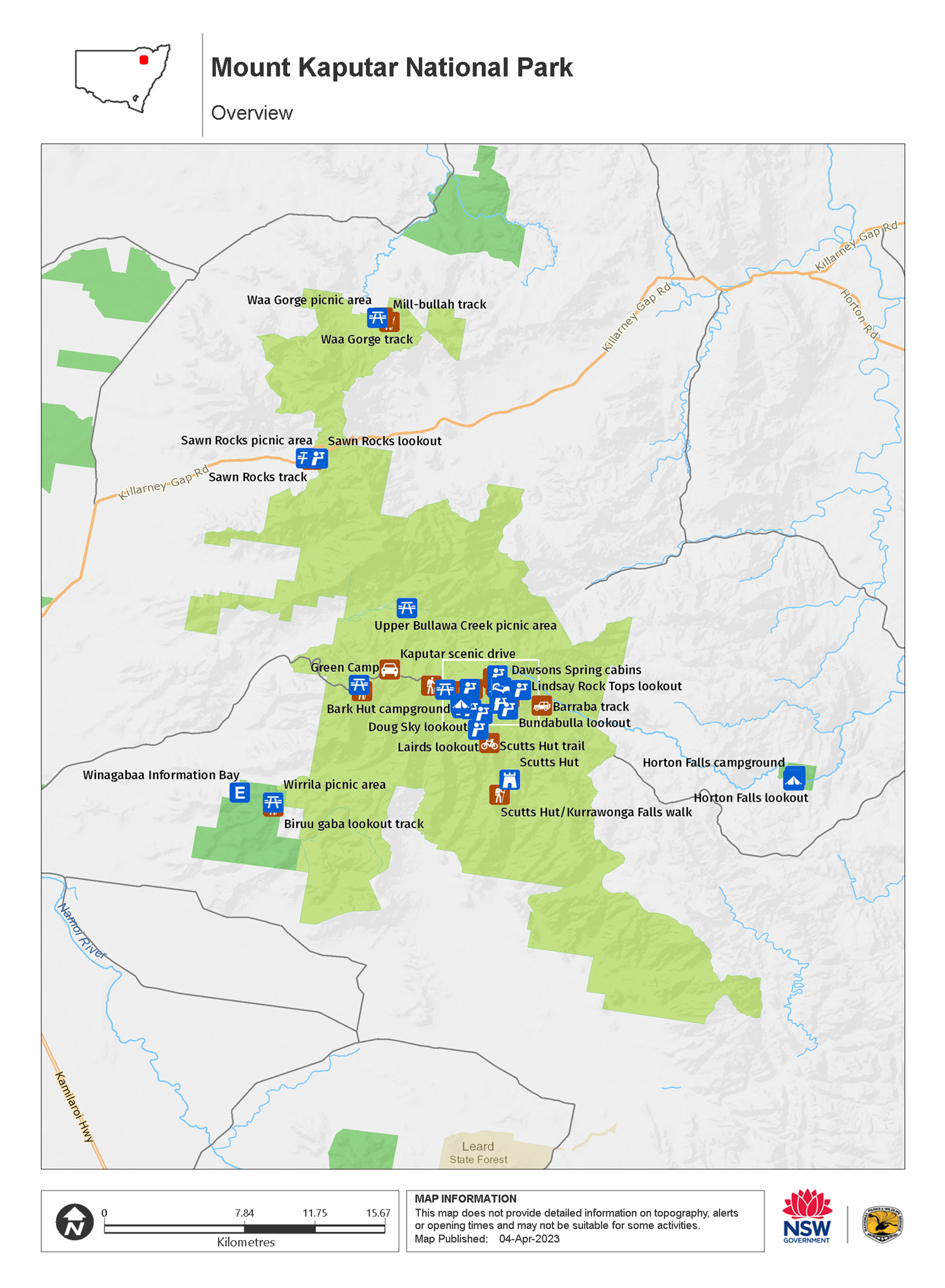
Map
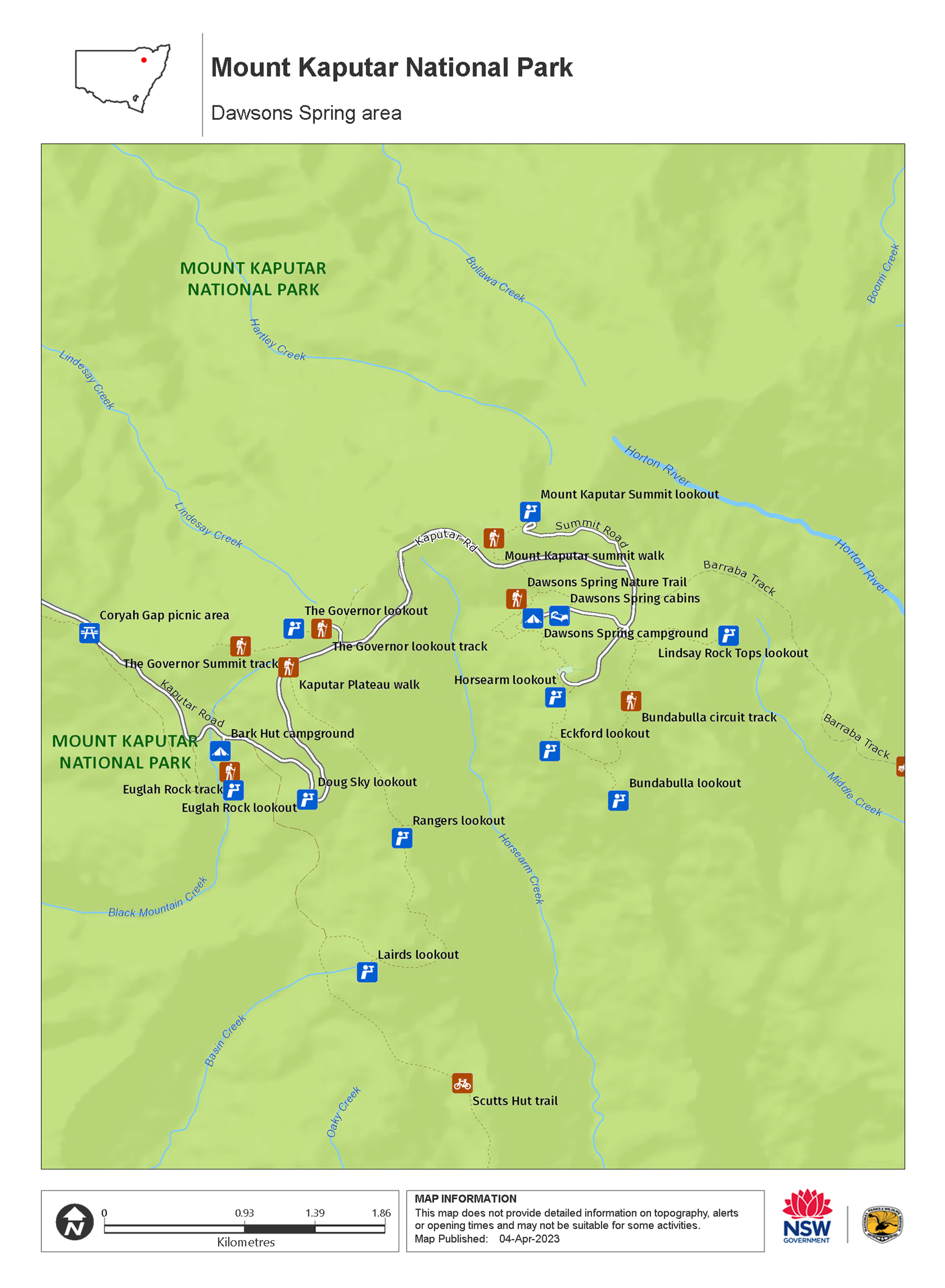
Map legend

Contact
- in the Country NSW region
Mount Kaputar National Park is always open but may have to close at times due to poor weather or fire danger.
-
-
Narrabri office
02 6792 7300
Contact hours: Monday to Friday, 8.30am to 4.30pm. - Level 1, 100 Maitland Street, Narrabri NSW 2390. Accessible via Dewhurst Street.
-
Email: npws.barwon@environment.nsw.gov.au
-
Narrabri office
Visitor info
All the practical information you need to know about Mount Kaputar National Park.
Getting there and parking
Get driving directions
Mt Kaputar Summit from Narrabri:
- Drive south along Old Gunnedah Road, then turn left onto Kaputar Road.
- Continue along Kaputar Road for around 27km until you reach the park entrance
- From here the road to the summit is steep and winding, with sections of unsealed road.
- No caravans or large motorhomes are permitted beyond this point
Sawn Rocks from Narrabri:
- Travel north along Newell Highway for around 3km, then turn right onto Killarney Gap Road.
- Continue along Killarney Gap Road for around 35km, then turn right at the Sawn Rocks turn-off. Drive around 100m to the Sawn Rocks car park.
Waa Gorge from Narrabri:
- Travel north along Newell Highway for around 3km, then turn right onto Killarney Gap Road.
- Continue along Killarney Gap Road for around 21km, then turn left onto Melburra Road towards Terry Hie Hie.
- Drive on Melburra Road for around 30km, then turn right onto Allambie Road.
- Follow Allambie Road for around 6.5km until you reach the park entrance. Waa Gorge carpark and picnic area is 1.5km from entrance.
- Please note: Allambie Road is open during dry weather only. The road is unsealed and passes through private property. Please respect landholders by closing gates, slowing for stock and staying off wet roads.
Caravans, motorhomes and camper trailers:
- Caravans and large motorhomes are not permitted past the park entrance. Some sections of Kaputar Road are narrow, winding and unsealed. You can park your caravan in Narrabri and make day trips into the park.
- Caravans are permitted on Killarney Gap Road to Sawn Rocks, however overnight stays are prohibited.
- Please drive slowly, turn on headlights and be aware of road conditions. It’s also a good idea to check current alerts for changed road conditions and closures before visiting.
Parking Show more
- Dawsons Spring campground See on map
- Doug Sky lookout See on map
- Green Camp See on map
- Mount Kaputar Summit lookout See on map
- Sawn Rocks picnic area See on map
- Upper Bullawa Creek picnic area See on map
- Waa Gorge picnic area See on map
- West Kaputar Rock lookout See on map
By bike
Check out the Bicycle information for NSW website for more information.
Best times to visit
There are lots of great things waiting for you in Mount Kaputar National Park. Here are some of the highlights.
Autumn
This is one of the best times of year to visit the park, with ideal temperatures for bush walking, cycling and camping.
Spring
A beautiful time of year to enjoy the abundant wildflowers and birds.
Summer
Escape the heat of the plains by heading up into the park. The mountains can be up to 10°C cooler than the surrounding towns and provide a relaxing refuge from the heat. Bring a book and relax under the shade of a towering snow gum.
Winter
Experience the mist surrounding the high plateau area and enjoy the beauty of the occasional blanketing of snow. The clear, sunny winter days are a great time to explore Sawn Rocks and Waa Gorge.
Facilities
Amenities
Toilets
- Bark Hut picnic area and campground
- Dawsons Spring cabins
- Dawsons Spring campground
- Sawn Rocks picnic area
- Waa Gorge picnic area
Picnic tables Show more
- Bark Hut picnic area and campground
- Dawsons Spring campground
- Green Camp
- Mount Kaputar Summit lookout
- Sawn Rocks picnic area
- Upper Bullawa Creek picnic area
- Waa Gorge picnic area
Barbecue facilities
Drinking water
Water that needs to be treated or boiled before drinking is available at:
Showers
Electric power
Maps and downloads
Prohibited
Pets
Pets and domestic animals (other than certified assistance animals) are not permitted. Find out which regional parks allow dog walking and see the pets in parks policy for more information.
Smoking
NSW national parks are no smoking areas.
Nearby towns
Narrabri (31 km)
Explore Pilliga Forest to see salt caves, native flora and fauna, and bore baths, or enjoy camping and bushwalking in Mt Kaputar National Park. Mt Kaputar's summit offers magnificent panoramic views, and there's excellent cabin accommodation within the park.
Moree (85 km)
Join a Heritage and Art Deco Guided Walk to uncover Moree's outstanding collection of period architecture. Wander along the main street of Moree which showcases heritage-listed buildings influenced by American, Egyptian, Greek and Spanish design practices.
Barraba (126 km)
Barraba is a birdwatcher's paradise - spot the rare Regent Honeyeater on one of the region's 14 bird routes, which have fine tree cover and good public access. There are plenty of great spots for bushwalking, such as through remnant rainforest in Mount Kaputar National Park.
Learn more
Mount Kaputar National Park is a special place. Here are just some of the reasons why:
Over 20 million years in the making
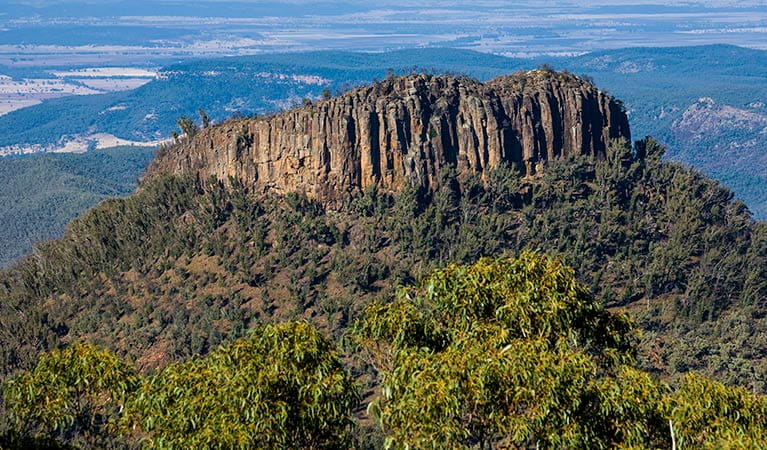
Two volcanos pushed Mount Kaputar high above the plains, and millions of years of erosion have carved a dramatic landscape of narrow valleys and steep ridges. Many of the mountains are ancient lava terraces. Experience ancient history for yourself by standing on Lindsay Rock Tops - an excellent example of a lava terrace. Or visit Sawn Rocks to see one of Australia's best examples of a spectacular rock formation called organ-piping - it really does look like a wall of giant organ pipes.
- Bundabulla circuit walking track Bundabulla circuit walking track connects several walking tracks together. It offers a terrific bushwalking experience with places to picnic along the way and views of Mount Kaputar and surrounds.
- Dawsons Spring nature trail Dawsons Spring nature trail is an easy walk from Dawsons Spring campground in Mount Kaputar National Park, near Narrabri. Great for families, you'll enjoy seasonal waterfalls, wildflowers and wildlife spotting.
- Doug Sky lookout Doug Sky lookout in Mount Kaputar National Park offers scenic views over north-west NSW and Warrumbungles.
- Kaputar scenic drive Kaputar scenic drive is a 20km driving route through dramatic landscapes, with access to lookouts, picnic spots and walking tracks.
- Sawn Rocks walking track This easy walk beside a shady creek bed leads you to a spectacular rock formation - the unique, organ-pipe cliff face of Sawn Rocks and scenic views.
Action or relaxation
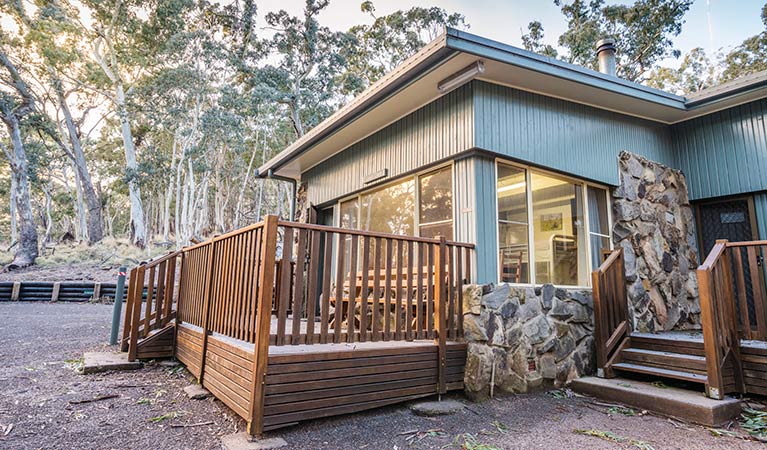
Mount Kaputar National Park is packed with walks, cycling and 4WD trails, plus plenty of scenic spots for camping and picnicking. Test your mountain bike legs up the steep Mount Kaputar Road to the Kaputar Plateau, or the challenging Barraba track. Enjoy a bite to eat at a serene picnic area before walking it off as you take in the stunning scenery. Don't miss the incredible Sawn Rocks formation. There's so much to see, why not book a cabin or set up camp for a few days to make the most of your country getaway.
- Sawn Rocks picnic area Sawn Rocks picnic area is located at the start of Sawn Rocks walking track in Mount Kaputar National Park. It’s ideal for barbecues and picnics with scenic views of North West NSW.
- Waa Gorge picnic area Waa Gorge is one of Mount Kaputar National Park’s most stunning attractions, and this picnic area offers enough sights to enjoy the show over a long lunch.
Colourful locals
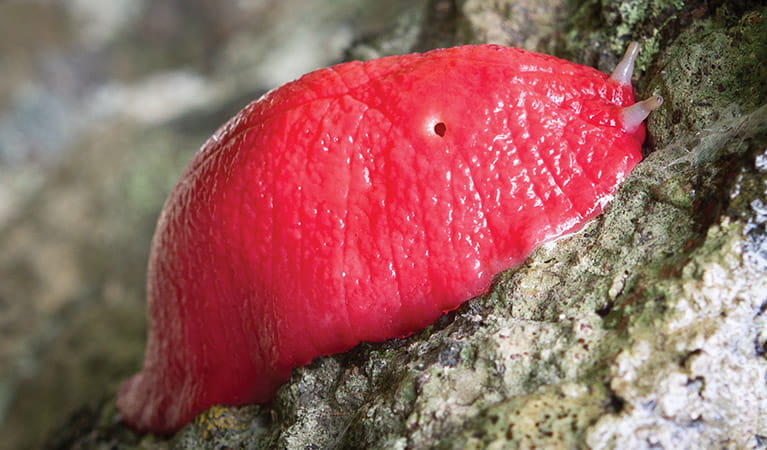
Mount Kaputar is famous for a very unusual, colourful local - a bright pink slug. It can be seen after rain on rocks, trees and amongst the leaf litter. With birds from both the east and west meeting together at Mount Kaputar, the park is also a wonderful place to go bird watching. More than 185 bird species live in the park, so don't forget your binoculars. A torch will also come in handy for seeing some of the other locals that come out at night, including possums and greater gliders. And watch out for the many kangaroos and wallabies, too.
- Dawsons Spring nature trail Dawsons Spring nature trail is an easy walk from Dawsons Spring campground in Mount Kaputar National Park, near Narrabri. Great for families, you'll enjoy seasonal waterfalls, wildflowers and wildlife spotting.
- Euglah Rock walking track Ideal for walking with kids, Euglah Rock walking track in Mount Kaputar National Park leads to a lookout offering stunning scenic views of Euglah Rock and beyond.
An ancient heritage
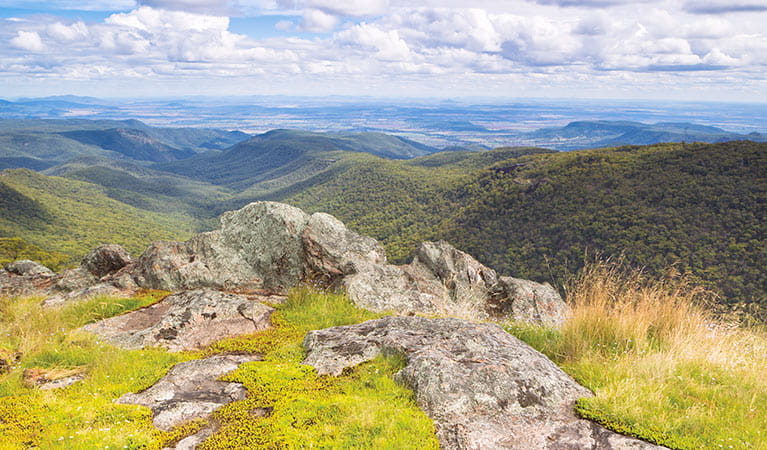
Mount Kaputar National Park is the traditional Country of the Gamilaroi Aboriginal people. The park provided a rich resource for food, medicines, shelter and weapons and the landscape is part of Dreaming stories. Reminders of the Gamilaroi's connection to this ancient landscape are evident in Aboriginal rock carvings, campsites, marks on trees and axe grinding grooves throughout the park.
A harsh lifestyle
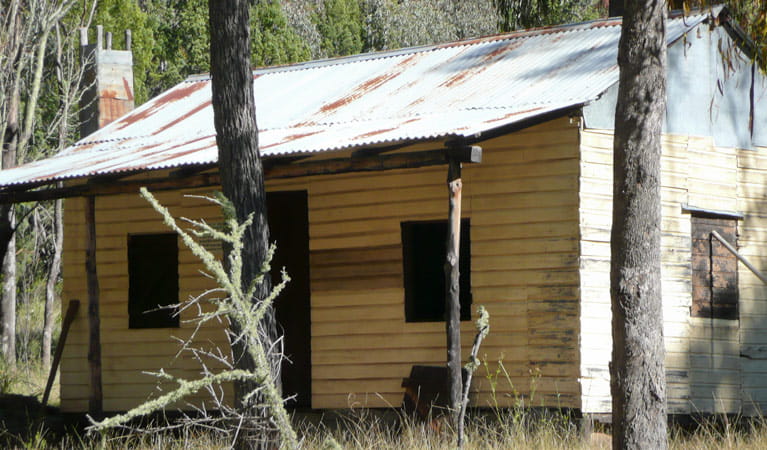
Several pioneering families lived in the Mount Kaputar area in extremely harsh conditions. Stockmen looked after sheep and cattle on the Kaputar Plateau, often going for months without seeing another person. Enjoy a walk to the historic Scutts Hut to experience the pioneers' harsh lifestyle. The Scutt family lived in the hut in the 1940s and 50s, and it has been carefully restored to its original condition. Most of the materials to build the hut and furniture were brought in by horse - even the rainwater tank.
Plants and animals protected in this park
Animals
-
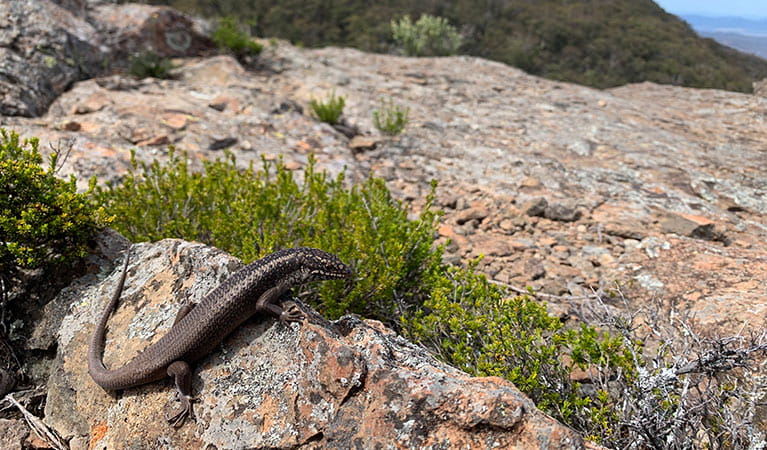
Kaputar rock skink (Egernia roomi)
The critically endangered Kaputar rock skink is found only in the high rocky peaks of Mount Kaputar National Park. With one of the smallest ranges of any vertebrate in NSW, this rare reptile is at risk of extinction.
-

Southern boobook (Ninox novaeseelandiae)
The southern boobook, also known as the mopoke, is the smallest and most common native owl in Australia. With a musical 'boo-book' call that echoes through forests and woodlands, the southern boobook is a great one to look out for while bird watching.
-
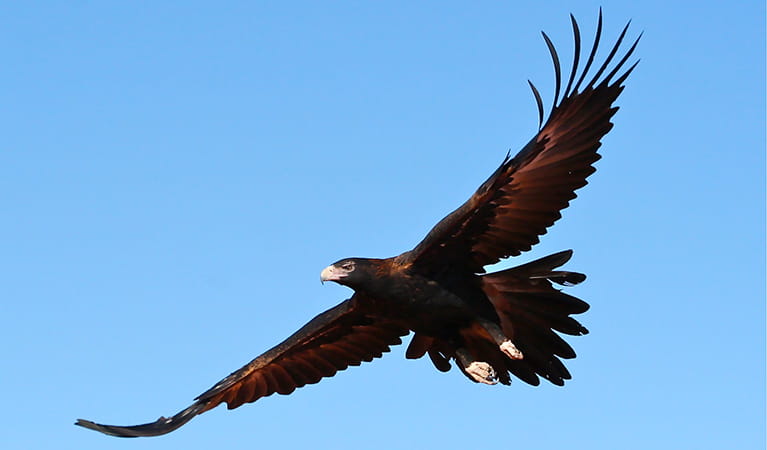
Wedge-tailed eagle (Aquila audax)
With a wingspan of up to 2.5m, the wedge-tailed eagle is Australia’s largest bird of prey. These Australian animals are found in woodlands across NSW, and have the ability to soar to heights of over 2km. If you’re bird watching, look out for the distinctive diamond-shaped tail of the eagle.
-
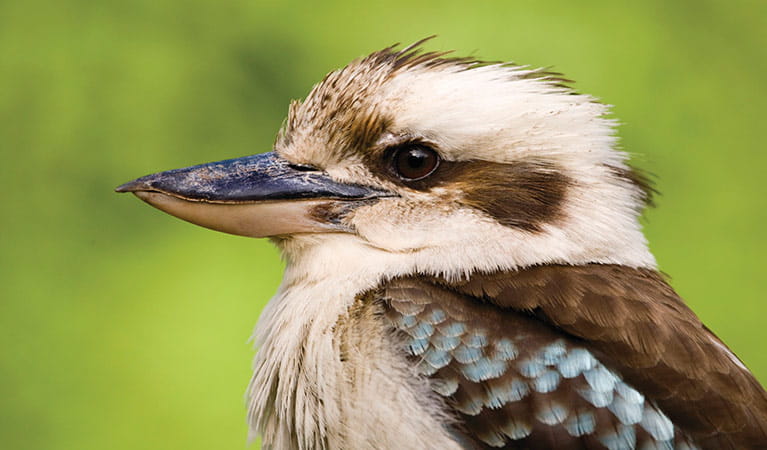
Kookaburra (Dacelo novaeguineae)
Of the 2 species of kookaburra found in Australia, the laughing kookaburra is the best-known and the largest of the native kingfishers. With its distinctive riotous call, the laughing kookaburra is commonly heard in open woodlands and forests throughout NSW national parks, making these ideal spots for bird watching.
Plants
-
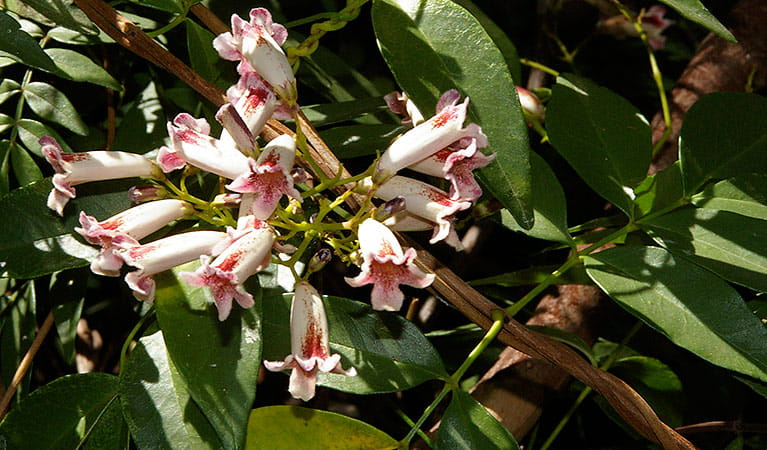
Wonga wonga vine (Pandorea pandorana)
The wonga wonga vine is a widespread vigorous climber usually found along eastern Australia. A variation of the plant occurs in the central desert, where it resembles a sprawling shrub. One of the more common Australian native plants, the wonga wonga vine produces bell-shaped white or yellow flowers in the spring, followed by a large oblong-shaped seed pod.
-

Grass tree (Xanthorrea spp.)
An iconic part of the Australian landscape, the grass tree is widespread across eastern NSW. These Australian native plants have a thick fire-blackened trunk and long spiked leaves. They are found in heath and open forests across eastern NSW. The grass tree grows 1-5m in height and produces striking white-flowered spikes which grow up to 1m long.
Environments in this park
Education resources (1)
What we're doing
Mount Kaputar National Park has management strategies in place to protect and conserve the values of this park. Visit the OEH website for detailed park and fire management documents. Here is just some of the work we’re doing to conserve these values:
Managing weeds, pest animals and other threats
Pests and weeds have a significant impact to ecosystems within Mount Kaputar National Park. Pest reduction of threats, such as goats, pigs and foxes, as well as ongoing risk assessments for new and emerging weeds, is an important part of the work NPWS does to protect the biodiversity values of this park.
Managing fire
NSW is one of the most bushfire prone areas in the world as a result of our climate, weather systems, vegetation and the rugged terrain. NPWS is committed to maintaining natural and cultural heritage values and minimising the likelihood and impact of bushfires via a strategic program of fire research, fire planning, hazard reduction, highly trained rapid response firefighting crews and community alerts.

